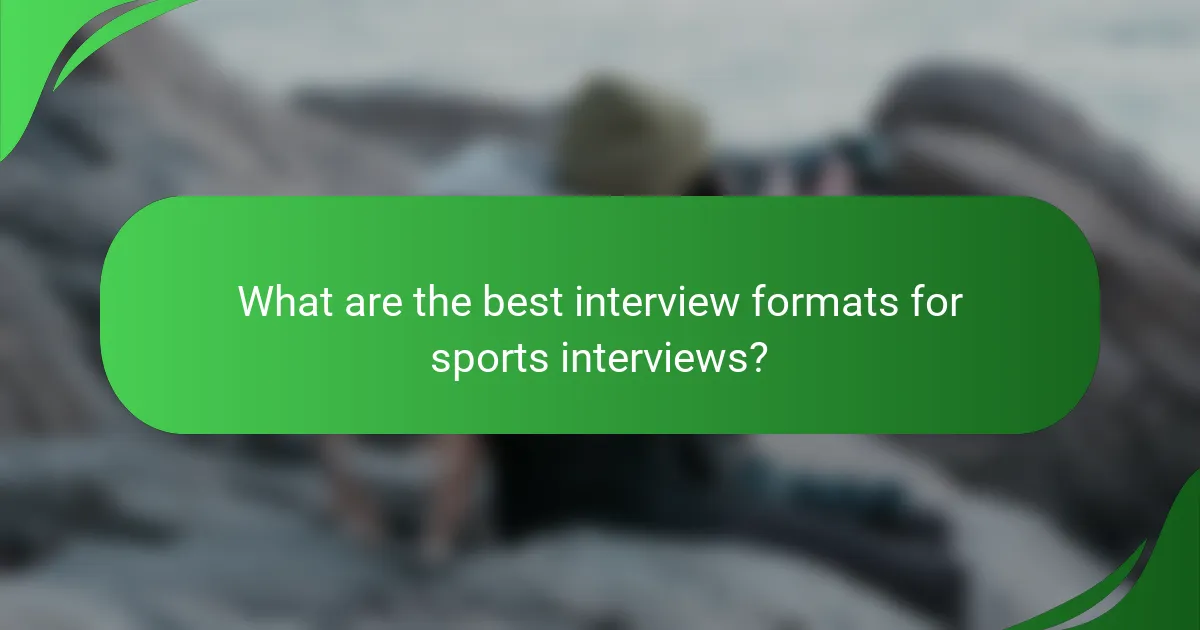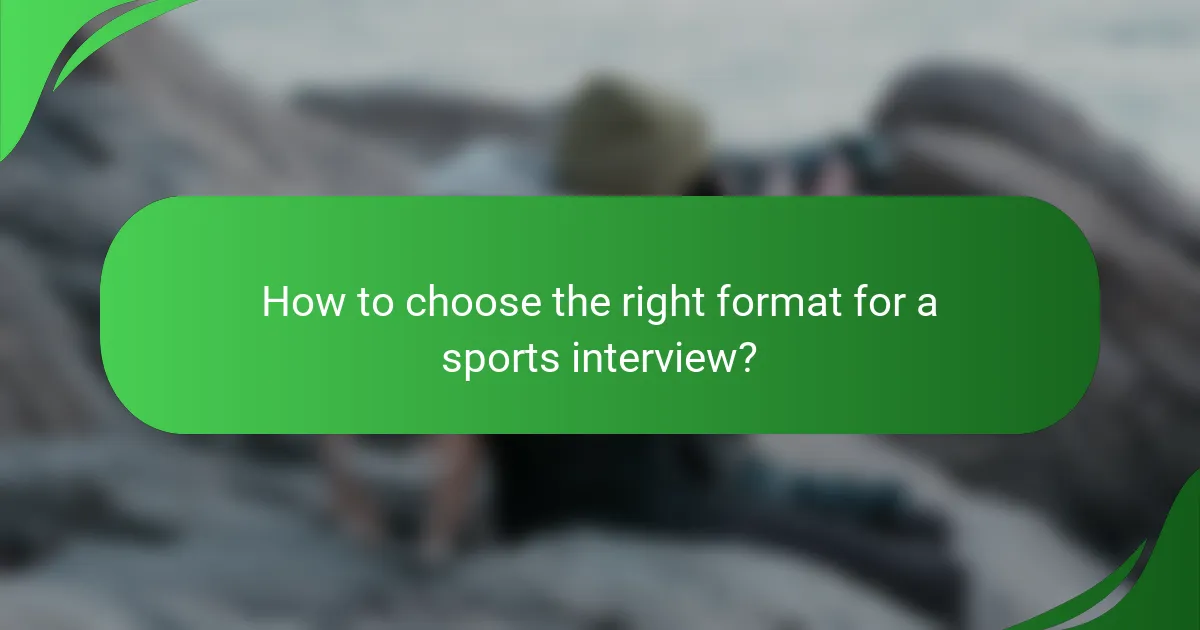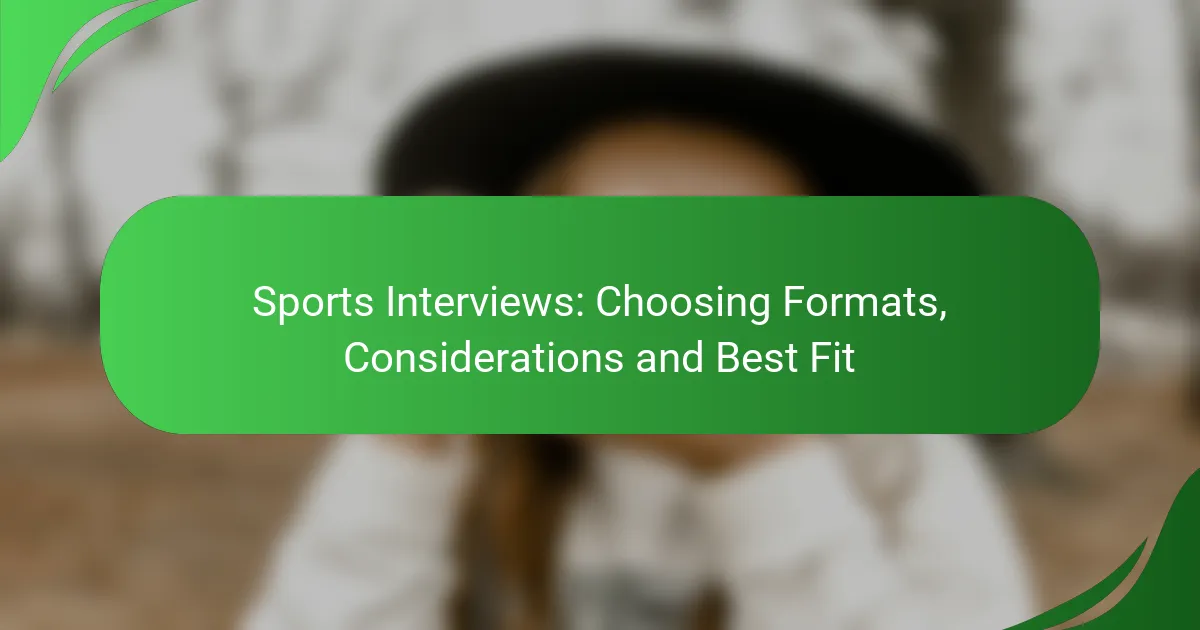Choosing the right format for sports interviews is essential to achieving the desired outcomes and engaging the audience effectively. Various formats, such as live interviews, podcasts, and written Q&As, each come with their own set of advantages and considerations that should align with the interview’s goals and the athlete’s comfort. By understanding the audience and preparing thoughtfully, interviewers can create a compelling and informative experience for both the interviewee and viewers.

What are the best interview formats for sports interviews?
The best interview formats for sports interviews depend on the goals of the interview, the audience, and the subject matter. Common formats include live interviews, pre-recorded sessions, panel discussions, podcasts, and written Q&As, each offering unique advantages and considerations.
Live interviews
Live interviews provide real-time interaction, allowing for spontaneous questions and immediate responses. This format is engaging for audiences, as it creates a sense of urgency and excitement. However, it requires thorough preparation to handle unexpected situations, such as technical difficulties or challenging questions.
Consider using live interviews during significant events, like game days or press conferences, where the atmosphere can enhance the discussion. Ensure that the interviewee is comfortable and prepared to speak on the spot to maximize effectiveness.
Pre-recorded interviews
Pre-recorded interviews allow for editing and refinement before the final release, ensuring clarity and professionalism. This format is beneficial for creating polished content, as it enables the interviewer to remove any awkward pauses or mistakes. However, it may lack the immediacy and excitement of live interactions.
Use pre-recorded formats for in-depth features or when discussing sensitive topics that require careful handling. This approach can also be advantageous when coordinating schedules with busy athletes or coaches.
Panel discussions
Panel discussions involve multiple participants, fostering diverse perspectives on a given topic. This format can enrich the conversation and provide a more comprehensive view of issues in sports. However, managing multiple voices can be challenging, and it’s crucial to ensure that all panelists have equal opportunities to contribute.
Consider organizing panel discussions for events like sports conventions or symposiums, where various experts can share insights. Establish clear guidelines for participation to maintain focus and coherence throughout the discussion.
Podcast formats
Podcasts offer a flexible and accessible way to conduct sports interviews, allowing listeners to engage with content on their own schedule. This format can range from casual conversations to structured interviews, catering to different audience preferences. However, the lack of visual elements may limit engagement for some listeners.
Utilize podcasts to reach a broader audience, especially younger demographics who prefer audio content. Consistency in episode length and release schedule can help build a loyal listener base.
Written Q&A
Written Q&As provide a straightforward format that allows for thoughtful responses and can be easily shared across various platforms. This format is particularly useful for reaching audiences who prefer reading over listening or watching. However, it may lack the personal touch of spoken interviews.
Consider using written Q&As for online articles or newsletters, where space and time constraints exist. Ensure that questions are clear and concise to elicit detailed responses from interviewees.

How to choose the right format for a sports interview?
Selecting the right format for a sports interview involves understanding the audience, the technical setup, the athlete’s comfort, and the interview’s purpose. Each of these factors plays a crucial role in ensuring the interview is engaging, effective, and aligned with the goals of both the interviewer and the interviewee.
Consider audience engagement
Audience engagement is vital for a successful sports interview. Formats like live Q&A sessions or interactive webinars can foster real-time interaction, while pre-recorded interviews might allow for more polished content. Assess the preferences of your target audience to choose a format that resonates with them.
For instance, younger audiences may prefer social media platforms for interviews, while traditional sports fans might appreciate televised formats. Tailoring the approach can significantly enhance viewer retention and interest.
Evaluate technical requirements
Technical requirements vary widely among different interview formats. Live streaming demands reliable internet connectivity and good audio-visual equipment, while in-person interviews require suitable locations and possibly additional gear. Ensure that all necessary technology is tested and functional before the interview.
Consider factors such as lighting, sound quality, and backup systems. For example, using a high-quality microphone can drastically improve audio clarity, which is essential for viewer comprehension.
Assess the athlete’s comfort level
The athlete’s comfort with the interview format is crucial for a genuine conversation. Some athletes may prefer informal settings like podcasts or casual chats, while others might feel more at ease in structured environments like press conferences. Understanding their preferences can lead to more authentic responses.
Before the interview, discuss the format with the athlete to gauge their comfort level. This can help in selecting a format that allows them to express themselves freely, ultimately leading to a more engaging interview.
Match format to the interview purpose
Aligning the interview format with its purpose is essential for achieving desired outcomes. For promotional content, visually engaging formats like video interviews may be more effective, while in-depth analysis might benefit from a podcast or written article. Clearly define the goals of the interview to guide your format choice.
For example, if the aim is to provide insights into an athlete’s training regimen, a detailed video or a long-form article may serve better than a brief social media post. Consider the depth of content required and choose a format that allows for adequate exploration of the topic.

What are the key considerations for conducting sports interviews?
Key considerations for conducting sports interviews include understanding the athlete’s background, preparing relevant questions, creating a comfortable environment, and managing timing and scheduling effectively. Each of these elements plays a crucial role in ensuring the interview is engaging and informative.
Understanding the athlete’s background
Knowing an athlete’s background is essential for tailoring the interview to their experiences and achievements. This includes their sports history, personal challenges, and cultural context, which can provide deeper insights into their motivations and perspectives.
Researching an athlete’s previous interviews, social media presence, and public persona can help identify themes or topics that resonate with them. This preparation can lead to more meaningful conversations and reveal unique stories that may not be widely known.
Preparing relevant questions
Crafting relevant questions is crucial for guiding the interview and keeping it focused. Questions should be open-ended to encourage detailed responses, and they should align with the athlete’s background and current events in their sport.
A good practice is to categorize questions into themes such as personal experiences, training routines, and future goals. This organization helps maintain a natural flow during the interview and ensures that all important areas are covered.
Creating a comfortable environment
Establishing a comfortable environment is vital for eliciting honest and open responses from athletes. This can be achieved by choosing a familiar setting, minimizing distractions, and allowing the athlete to feel at ease before the interview begins.
Additionally, using a friendly tone and showing genuine interest in their stories can help build rapport. Avoiding overly aggressive questioning techniques can also contribute to a more relaxed atmosphere.
Timing and scheduling
Effective timing and scheduling are important for maximizing the quality of the interview. It’s best to schedule interviews at times when athletes are not preoccupied with training or competitions, allowing them to focus fully on the conversation.
Consider allocating sufficient time for the interview, ideally between 30 minutes to an hour, to allow for in-depth discussions. Flexibility in scheduling can also help accommodate the athlete’s availability, leading to a more productive session.

What are the benefits of different sports interview formats?
Different sports interview formats offer unique advantages that can enhance viewer experience and content quality. By selecting the right format, interviewers can engage audiences more effectively, deliver content flexibly, tell compelling stories, and reach a wider audience.
Increased viewer engagement
Engagement levels can vary significantly based on the interview format chosen. Formats such as live Q&A sessions or interactive social media interviews tend to capture audience attention more effectively than traditional one-on-one interviews. Utilizing polls or real-time questions can further enhance this engagement.
For instance, a live-streamed interview allows viewers to participate directly, fostering a sense of community and involvement. This can lead to higher viewer retention and interaction rates, making the content more appealing.
Flexibility in content delivery
Different formats provide various options for delivering content, allowing interviewers to adapt to their audience’s preferences. For example, short clips can be shared on social media for quick consumption, while longer, in-depth interviews can be hosted on podcasts or video platforms.
This flexibility enables creators to tailor their content to fit different platforms and audience needs, ensuring that the message reaches viewers in the most effective manner possible. Consider using a mix of formats to cater to diverse audience segments.
Enhanced storytelling opportunities
Choosing the right interview format can significantly enhance storytelling capabilities. Formats that allow for visual elements, such as video interviews or documentary-style presentations, can create a more immersive experience for the audience.
For example, incorporating behind-the-scenes footage or personal anecdotes during interviews can deepen the narrative and make the content more relatable. This approach not only captivates viewers but also helps convey the athlete’s journey more compellingly.
Broader audience reach
Different interview formats can help expand the reach to various audience demographics. For instance, podcasts may attract listeners who prefer audio content, while video interviews can engage those who enjoy visual storytelling.
Utilizing multiple formats across platforms can maximize exposure. For example, repurposing a video interview into a blog post or social media snippets can help reach audiences who consume content differently, ultimately broadening the overall audience base.

What are the challenges in sports interviews?
Sports interviews present various challenges, including the need for effective communication, managing athlete emotions, and navigating media expectations. Interviewers must balance the desire for insightful responses with the athletes’ comfort and willingness to share.
Understanding the athlete’s perspective
To conduct a successful sports interview, it’s crucial to understand the athlete’s viewpoint. Athletes often face immense pressure, which can affect their willingness to engage openly. Recognizing their emotional state and being empathetic can lead to more authentic responses.
Interviewers should consider the timing of the interview, especially after a game. Athletes may be elated or devastated, influencing their openness. Choosing the right moment can significantly impact the quality of the interview.
Balancing personal and professional questions
Striking a balance between personal and professional inquiries is essential in sports interviews. While fans are interested in an athlete’s life outside of sports, interviewers must respect boundaries to avoid discomfort. Asking about personal experiences can humanize the athlete but should be approached with sensitivity.
Effective interviewers often prepare a mix of questions that allow athletes to share their stories while maintaining professionalism. This approach can foster a more relaxed atmosphere, encouraging athletes to open up.
Navigating media expectations
Media expectations can create additional challenges during sports interviews. Reporters often seek sensational stories or controversial statements, which can pressure athletes to respond in ways that may not reflect their true feelings. Understanding these dynamics is crucial for interviewers.
Interviewers should aim to create a safe space for athletes, allowing them to express themselves without fear of misinterpretation. Clear communication about the interview’s purpose and the intended audience can help manage expectations on both sides.



